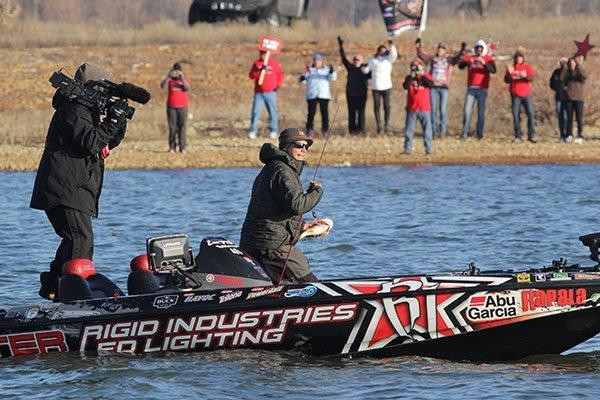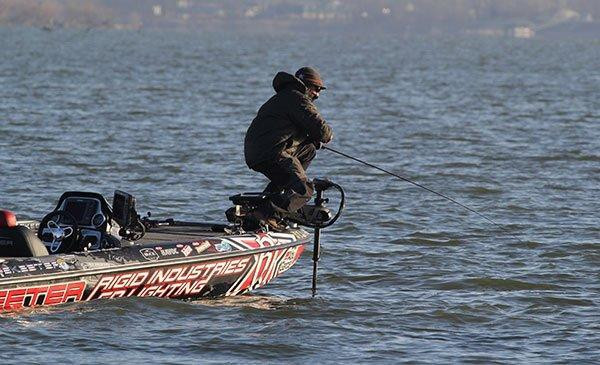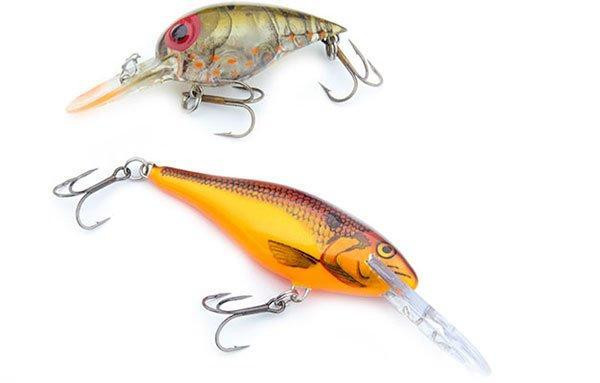Just because it’s cold outside doesn’t mean you can’t use crankbaits to catch bass. We’re always told to slow our presentations down in cold weather and the versatility of crankbaits actually gives you that ability more so than most techniques.
Elite Series pro Brandon Palaniuk has a lot of success bass fishing with crankbaits throughout the winter months. Whether the fish are transitioning into or out of their wintertime patterns, this technique allows him to cover various water depths while specifically catering to the activity—or lack thereof—of big bass.
According to him, there are 10 easy things modifications you can do to drastically increase your coldwater cranking success.
1. Hunker down
Efficiency is imperative in bass fishing but it plays an even larger role throughout the winter months. It’s important to cover a lot of water when looking for a pattern, but knowing when to saturate an area can pay big dividends.
“A lot of anglers catch fish in the wintertime and continue moving along,” Palaniuk said. “But the late fall and winter are the best times to absolutely load the boat. If you find aggressive fish willing to eat your crankbait, more times than not there are going to be a lot of them there. They can group up into massive schools and become very easy to catch.”
Fortunately for anglers, these aggressive schools don’t move much throughout the winter. If you can cover water quickly with a crankbait until finding the mother lode, there’s a great chance you’ll be able to pound on the same group of bass for several weeks.
2. Avoid dead water—find where the bass go to “winter”
In fisheries around the country, especially in lakes fed by river systems, bass “winter” in very specific and predictable places. I’ve never considered the word “winter” a verb, but after hearing Palaniuk’s theory, it makes a lot of sense.
Know your wind! If the air temperature is higher than the water temperature, wind is a huge help when cranking in cold water. If the air temperature is colder than the water, the water mixes with the colder air and pushes fish to deeper water.
“If your lake has a river system running through it or has fluctuating water levels, you’ll have specific areas in which the bass congregate throughout the winter,” Palaniuk said. “Let’s say your lake is 10 miles long—when the cold weather hits, the majority of the bass will get stacked up in a small, one or two-mile stretch of water. If you can find this area, your odds of catching them will skyrocket.”
Although it can vary by lake and geographic location, start searching for these areas in the southern parts of your local fishery. The further you are from the cool runoff of rivers and creeks, the better off you’ll be.
“When I was fishing at home last week, the water was 44 degrees and the air temperature was 35 degrees, but there were schools of big largemouth roaming around in less than three feet of water,” Palaniuk said. “Just a mile away, you couldn’t find any population of shallow fish. That tells me the bass were using this water to ‘winter’.”
3. Give ‘em some tip
Bass are much less apt to chase prey in cold water, which makes it essential to give them more time to eat your crankbait. Palaniuk accomplishes this by using his rod tip to his advantage.
“Anytime you’re fishing a crankbait, the lure is probably moving away from the bass,” Palaniuk said. “It’s not a jig or a worm, so you have to let the fish eat that bait. To do this, I point my rod tip at the bass for a split-second before setting the hook so I don’t rip the hooks from its mouth. This ensures the bass is able to get as many hooks in its mouth as possible. If you let your rod load before the hookset, you’ll have a better chance of getting them in the boat.”
4. There’s always an exception to the rule
The action of a crankbait is often the determining factor in its ability to catch fish. While a tight wobble is preferred by many anglers in the winter, Palaniuk has a lot of success going against the grain by using crankbaits with a wider action.
“In most cases, a small, flat-sided crankbait like a Rapala Shad Rap will be my starting point in cold water,” Palaniuk said. “But just like anything else, there’s always an exception. Look at the Wiggle Wart for example—it has a very wide wobble and it catches a ton of fish in cold water. I can’t explain everything a bass does, but again, I think we give them too much credit.”
In order to get a good idea of the bass’ preference, try to throw out all of your preconceived notions and have several different crankbaits rigged and ready to go. If you can cover enough water while alternating your crankbaits, it won’t take long to hone-in on what the big ones want.
5. Remember—it’s just a bass
If you talk to enough bass anglers, you’ll find some that swear by different treble hook styles during different times of the year. Palaniuk doesn’t overthink things, especially in the winter.
Did you know? Rocks hold heat better and longer than other bass cover, so Palaniuk suggests making them a staple in your coldwater cranking endeavors.
“We give bass way too much credit,” Palaniuk said. “They outsmart us because we give them the opportunity to. If you have confidence in a specific type of treble or a certain crankbait color—throw it. Confidence and a positive attitude make a big difference in wintertime fishing, so just go with what you know and you’ll catch fish.”
Palaniuk may not get too caught up in changing treble hook styles in accordance to water temperature, but he does stress the importance of using ultra-sharp hooks. When a coldwater bass eats a crankbait, it’s not always because it’s hungry. Reaction strikes often result in cheek-hooked bass, so keeping your gear in top-notch condition can avoid some serious heartbreaks.
“You always want your crankbait to be colliding with something, whether it’s cover or the bottom,” Palaniuk said. “When you bang into things for a few hours, your hooks are going to take a beating and become dull. It’s crucial to check your hooks every few minutes between casts and replace them if they’re not up to par.”
6. Slow down
Coldwater bass are sluggish, moody little creatures. Their metabolism is dreadfully slow so they don’t have to eat as much to stay full and more than likely, they’re not going to swim very far or quickly to eat your crankbait. Catering your retrieve to their mood will give you a much better chance at catching them.
“I’m almost always going to utilize a slower retrieve in cold water,” Palaniuk said. “They don’t want to move a lot, so you have to give them a chance to catch your crankbait without exerting too much energy. That’s why I love to crank in cold water—even though they’re not looking to eat, you can always make them react. I experiment by stopping the crankbait mid-retrieve, burning it and then slowing it down to a crawl or just crawling it across rocks. The possibilities are endless but there’s always one retrieve that will get more bites than others.”
It may be tempting to use a lower gear ratio reel for such a slow presentation, but Palaniuk prefers a 6.4:1 Abu Garcia REVO Premier Generation 3 Casting Reel. It may take a bit more discipline to slow yourself down, but it will give you more control over the crankbait while also allowing you to quickly retrieve slack when a bass hits the crankbait from behind.
7. Use the correct rod angles
The use of proper rod angles can either make or break a day of cold water crankbait fishing. In the majority of situations, holding your rod at a 45-degree angle to your target will make a huge difference in your success.
Quick tip: Palaniuk is a big proponent of fluorocarbon line in the winter. He most often uses 12-pound Berkley Trilene 100% Fluorocarbon to help keep his bait close to the bottom when cranking.
“Whenever I’m cranking rock or open water in the winter, I keep my rod tip down and hold it at a 45-degree angle,” Palaniuk said. “If you point your rod tip directly at your crankbait, you’re not going to feel what it’s doing which will result in missed bites. In addition, this angle also gives you plenty of room to execute a sweeping hookset without torquing your back and getting yourself out of position to fight a big one.”
If you’re lucky enough to find lively, green submerged vegetation this winter, Palaniuk suggests holding your rod at a 90-degree angle. This will allow you to “tick” the top of the grass while giving you the ability to rip your crankbait free from any thick patches.
8. Upsize your crankbait to maintain bottom contact
Whenever you’re fishing a crankbait, you always want to be in contact with something—as your crankbait glances off of cover, it can trigger a bass’ natural reaction to attack. This can be challenging in cold water, however, because a slow retrieve makes it difficult to maintain bottom contact. To work around this conundrum, Palaniuk will often upsize his crankbait.
“If you want to fish a crankbait in shallow water while maintain bottom contact with a slow retrieve, you can use a larger crankbait,” Palaniuk said. “This will let you slow down and crawl it along the bottom. If you can’t feel the bottom with a shallow crankbait, upsize to a deeper-running Wiggle Wart so you can dredge the bottom with a super-slow retrieve. It’s exactly what I did in the 2013 Classic on Grand Lake.”
9. Move with the bass during the fight
Palaniuk is widely renowned for his front deck movements when fighting big crankbait fish. We’ve all seen him squat, kneel and gyrate all over the boat, but why? According to him, the fight is the ultimate do-or-die time.
“It’s tough to catch a bunch of fish in cold water, so when you’ve been busting your butt all day to get a bite, you have to do everything in your power to put that fish in the boat,” Palaniuk said. “When I hook a crankbait fish, allowing myself to move gives the fish less of a chance to come off. If you hold the rod in one position and keep reeling, it’s going to come off a lot of times.”
When a crankbait fish surges or changes directions, Palaniuk makes an effort to move with the fish—the more in-sync he is with the fish, the more pressure he’s able to keep on it. You’ll also see him kneel while keeping his rod tip very low to the water. Sure, it’s exciting to watch on television but it isn’t for theatrics.
“Any time you have a bass hooked with treble hooks, you need to keep their head underwater,” Palaniuk said. “As soon as it jumps and gets some slack line, the fight is completely out of your hands. You never, ever want to have slack in your line, so you have to keep them from jumping by keeping your rod tip low.”
10. Learn to read your bites
Catching a big crankbait bass in cold water is definitely exciting, but try not to get carried away. Before you unhook it, look for important clues that will lead to more fish catches.
Have realistic expectations: According to Palaniuk, you’re not always going to catch huge numbers of bass in super-cold water, so it’s important to know what to expect. If you’re getting ten bites a day, he says you’re ahead of the curve.
“If I catch a bass that’s only hooked with the back treble, that tells me that I need to change something,” Palaniuk said. “It usually means I need to change my cadence or color. You may have to go from a Shad Rap to an Arashi Flat or from an Arashi Flat to a Wiggle Wart—you have to constantly experiment. If the bass is hooked by the front treble, I don’t change a thing.”
It’s also good practice to pay close attention to how the bass bites your crankbait. As we discussed earlier, wintertime bass can be found in large groups and the way they bite can be a dead giveaway to more exciting action.
“Bass are extremely competitive feeders, so you’re definitely going to get more aggressive strikes in the winter when there are more than one fish around,” Palaniuk said. “When they slowly load up and act sluggish, that’s a sign that the bass isn’t competing with anything else. Most coldwater cranking bites are sluggish, so just one aggressive bite can give you a lot of clues.”
Cold weather isn’t always indicative of slow bass fishing action, so don’t let the passing of the pleasant fall weather discourage you from crankbait fishing. If you can make these simple adjustments to your coldwater cranking approach, you’ll be able to continue enjoying hot crankbait action, even in frigid weather.
What is your favorite coldwater crankbait? What’s the biggest bass you’ve ever caught on it?
















